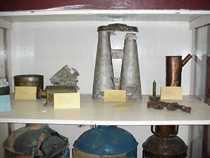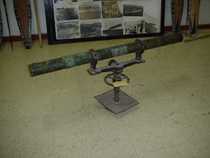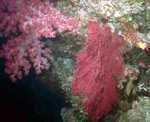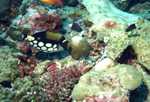| |

Today was the last -- and possibly the best -- day of wreck diving in Chuuk Lagoon. I'll tell you all about the amazing things I saw on Nippo Maru and the Kiyozumi Maru. These wrecks and the reefs that have grown around them are really incredible sights, and remind me of how important it is for us to be aware of and to protect against dangers that threaten our reefs.
Nippo Maru
Today we had to get off to an early start because we were planning to dive on the Nippo Maru. Since the wreck is in deeper water than the others we've dived, we knew it would take us longer to reach the dive location. I was very excited about this dive because there would be some special artifacts to see. The Nippo functioned as a water carrier but it also transported wheeled artillery guns, ammunition, and -- most exciting to me -- tanks.
Shortly after starting our descent, Karen signaled to me that she was unable to clear her left ear. After 5 frustrating minutes she signaled she would head back to the surface. I knew Karen would be very disappointed to miss this dive.
Davie (our dive guide) and I continued our floating descent until we reached the deck of the ship at 105 feet. We started swimming slowly along the port (left) side of the deck toward the bow (front) of the ship. Within a few minutes we came to our first location: a one-man Japanese tank sitting upright on the ship's deck.
The tank had so much coral growing on it that at first I did not even recognize what it was. However, within seconds I could easily make out the treads, the turret, and the short gun barrel.
Next we dropped down into hold # 2 which contained a large number of 6-inch artillery shells. Davie and I slowly floated out of hold # 2 and dropped to a depth of 120 feet in hold # 1. This hold included sake bottles and a collection of Japanese gas masks. It almost seemed like ghosts were peering back at me through the glass eyepieces in the masks. It was an eerie feeling and I was kind of glad when Davie signaled it was time to head out of the hold.
(Click on any photo to enlarge it.)
These binoculars from the Nippo Maru were
probably once used by the captain of the ship.
 Heading toward the stern of the ship, we leveled out at around 80 feet and swam directly through a window into the ship's wheelhouse. Marine worms had long ago eaten away the wood of the ship's steering wheel, but the large round brass portion of the wheel was still there. I held the wheel in my hands and looked out through the wheelhouse window over the bow of the ship, feeling much like the captain of this strange underwater ghost ship.
Heading toward the stern of the ship, we leveled out at around 80 feet and swam directly through a window into the ship's wheelhouse. Marine worms had long ago eaten away the wood of the ship's steering wheel, but the large round brass portion of the wheel was still there. I held the wheel in my hands and looked out through the wheelhouse window over the bow of the ship, feeling much like the captain of this strange underwater ghost ship.
Our last stop was over the stern (back) of the ship where, on the starboard (right) side, I could make out several artillery guns. The barrels still pointed up, toward a long gone American target.
Time was up, and we had to stop briefly to decompress before we could surface. As we slowly floated upwards I was able to get one last look at the outline of the Japanese tank.
Kiyozumi Maru
The Kiyozumi Maru was the last wreck that Karen and I explored on this trip to Chuuk Lagoon.
Gunners on the Kiyozumi Maru used this range
finder to determine the distance to a target.
 Immediately upon dropping into the water I could tell this would be an interesting dive. Earlier in the day when I dove on the Nippo I had close to 80 feet of visibility. However, in the area of the lagoon where the Kiyozumi rests on its port side, swarms of green plankton limit the visibility to only 30 feet. There were big jellyfish everywhere. I have never seen so many in one place before.
Immediately upon dropping into the water I could tell this would be an interesting dive. Earlier in the day when I dove on the Nippo I had close to 80 feet of visibility. However, in the area of the lagoon where the Kiyozumi rests on its port side, swarms of green plankton limit the visibility to only 30 feet. There were big jellyfish everywhere. I have never seen so many in one place before.
During the attack on Chuuk Lagoon the Kiyozumi was bombed repeatedly and was hit twice in the fore ship area. These two hits made the 450-foot ship sink fast -- so fast that it was still anchored to the sea floor.
As Karen and I swam toward the stern of the ship, we passed hundreds of bulbous jellyfish that were pulsing through the plankton-rich water. Entering into the first cargo hold, we found several bicycles hanging from the bulkhead. Their rear wheels pointed downward and the seats had long since deteriorated.
Shortly after swimming out of the cargo hold, my light illuminated a gray-white object. As I got closer I realized that what I was looking at was a jawbone of a Japanese sailor that died 55 years ago during Operation Hailstone. After 4 days of diving in and around remnants of World War II, finding something so human was very sobering.
Karen and I looked at each other and then once again joined the jellyfish in a slow float back toward our anchor line before ascending to the surface.
Dangers to Coral Reefs
 As you can tell from following along our trip, Karen and I love to scuba dive. Part of our fascination with diving comes from being able to examine how wrecks, like the Nippo Maru, have evolved into tropical coral reefs. Observing all the colors and thousands of organisms that make up a reef is an incredible experience.
As you can tell from following along our trip, Karen and I love to scuba dive. Part of our fascination with diving comes from being able to examine how wrecks, like the Nippo Maru, have evolved into tropical coral reefs. Observing all the colors and thousands of organisms that make up a reef is an incredible experience.
That's why it is so sad that coral reefs around the world are in danger because of human activities. Coral reefs have always had to cope with the rigors of nature. Luckily, reefs have been able to survive because they usually have enough time between short-term impacts to recover.
Today, the stresses placed on reefs are increasing and becoming more frequent so that there is less time between events for reefs to recover. When humans do harmful things to reefs, reefs suffer and often don't recover for a long time. And, when they do recover, they are always a bit different, so the ecosystem that was there before is lost forever. Some human activities that threaten reefs include dumping, eutrophication, and overfishing.
Dumping garbage, oil, or heavy metals into the ocean can badly damage reefs because the materials pollute the water. For instance, each time there is an oil spill, the coral and the reef life have to begin building again from square one.
Another problem is eutrophication. Eutrophication is the scientific term used to describe the process when the amount of nutrients in water increases. These nutrients are not always good for the water. Some nutrients pollute water and kill reefs.
Overfishing is an additional danger. When fishermen overfish an area, they may remove plant-eating fish. Without plant-eating fish to eat algae, more algae grow. There have been cases when entire reefs were overgrown by algae, killing the coral and other reef life.
Reef-eating animals, like the Crown of Thorns Starfish (COTS), pose a natural threat to reef life. This starfish eats the coral tissue and leaves only dead skeletons. The last outbreak affected 17 percent of the Great Barrier Reef. Scientists don't know exactly what causes COTS outbreaks, but many factors could contribute to them. Eutrophication of reef waters helps more young COTS to survive. Overfishing reduces the number of natural predators that eat COTS. The more COTS that survive, the greater the damage they can do.
 Keeping reefs healthy is a real balancing act. Our influences may be direct, such as erosion from boat anchors, or indirect, such as increased nutrient levels. Either way, we need to take measures to understand and maintain the natural balance that makes a reef one of the richest biological environments we know.
Keeping reefs healthy is a real balancing act. Our influences may be direct, such as erosion from boat anchors, or indirect, such as increased nutrient levels. Either way, we need to take measures to understand and maintain the natural balance that makes a reef one of the richest biological environments we know.
Tom
|


